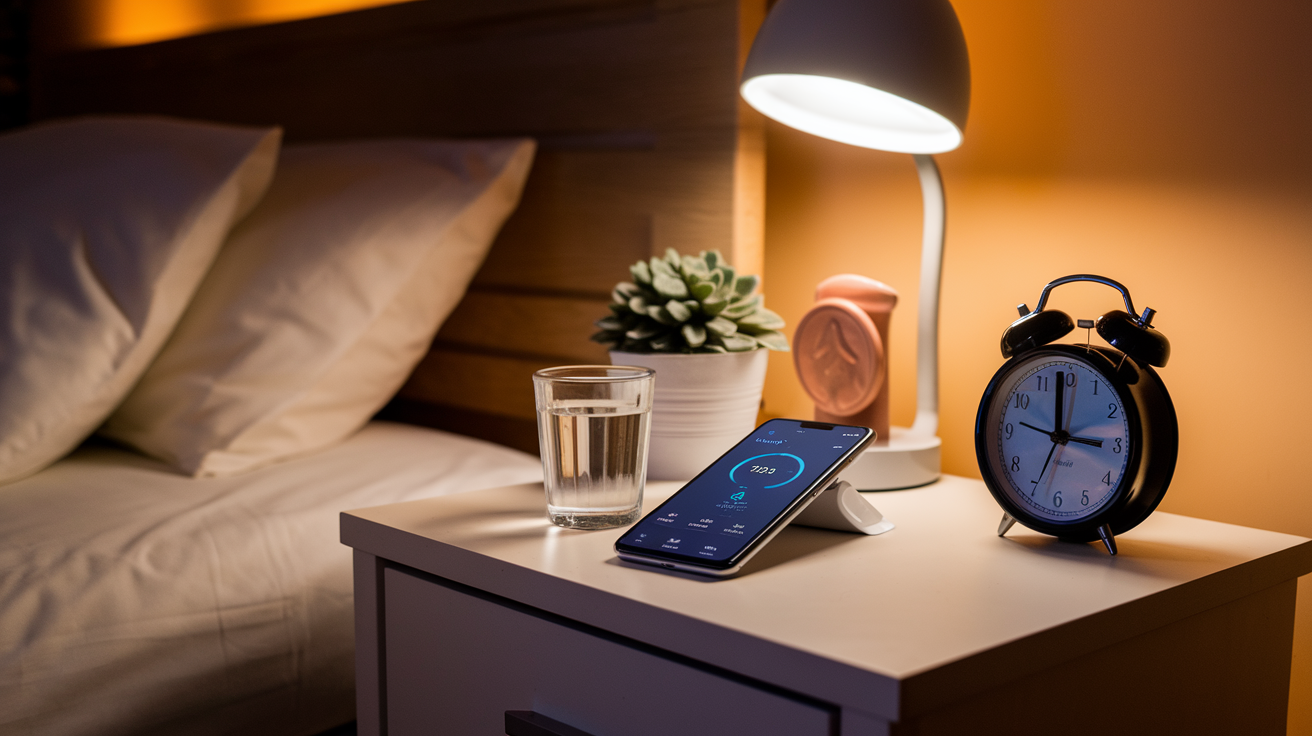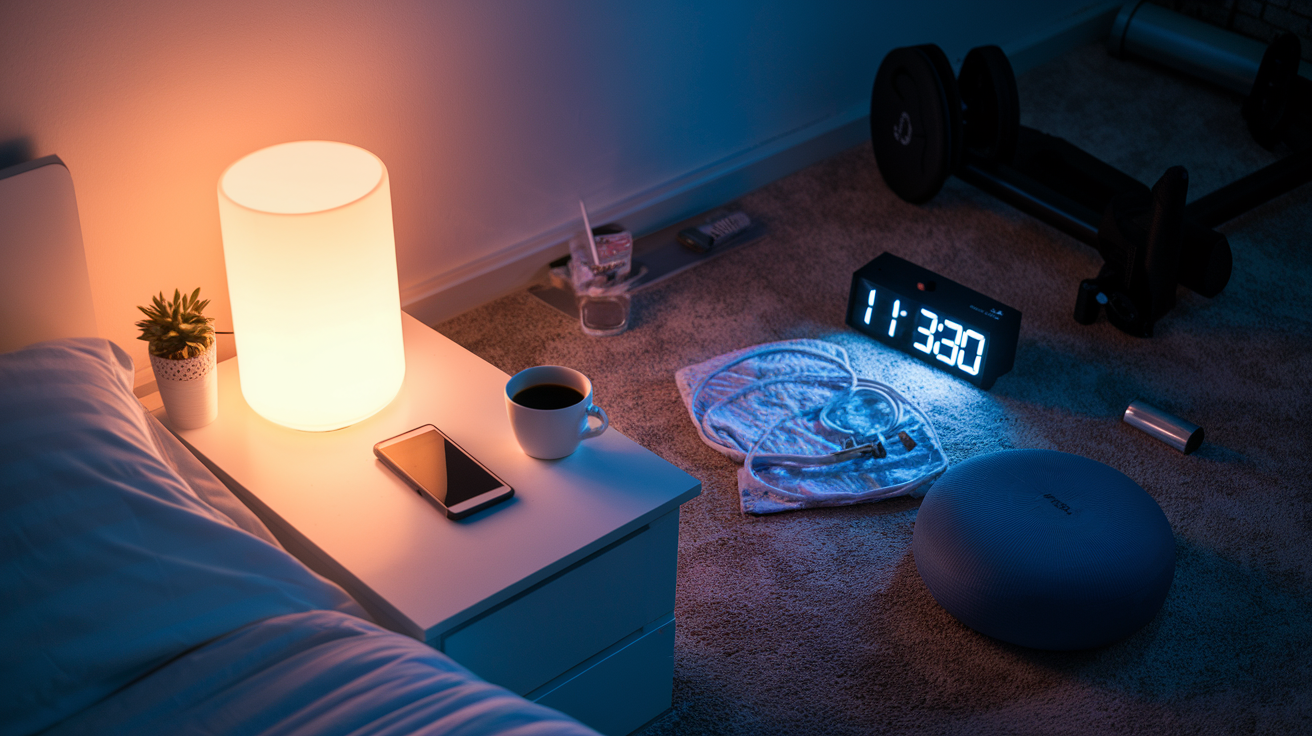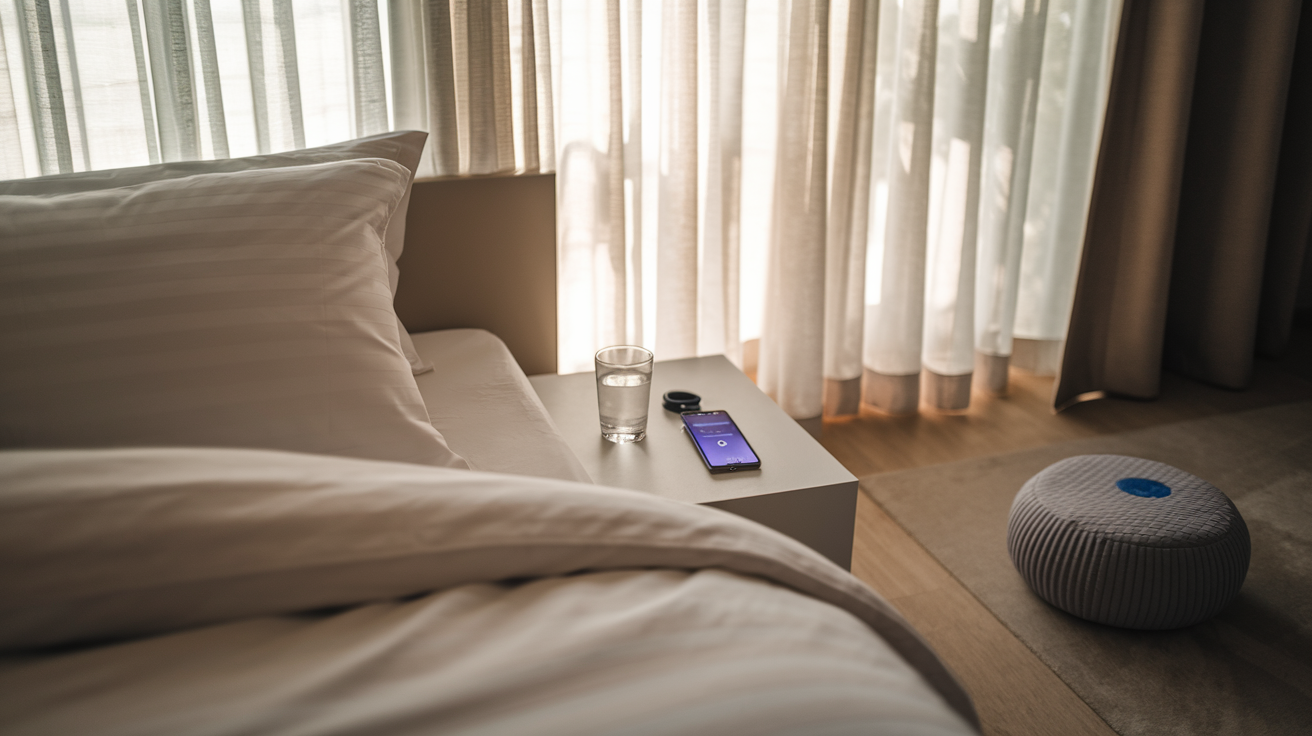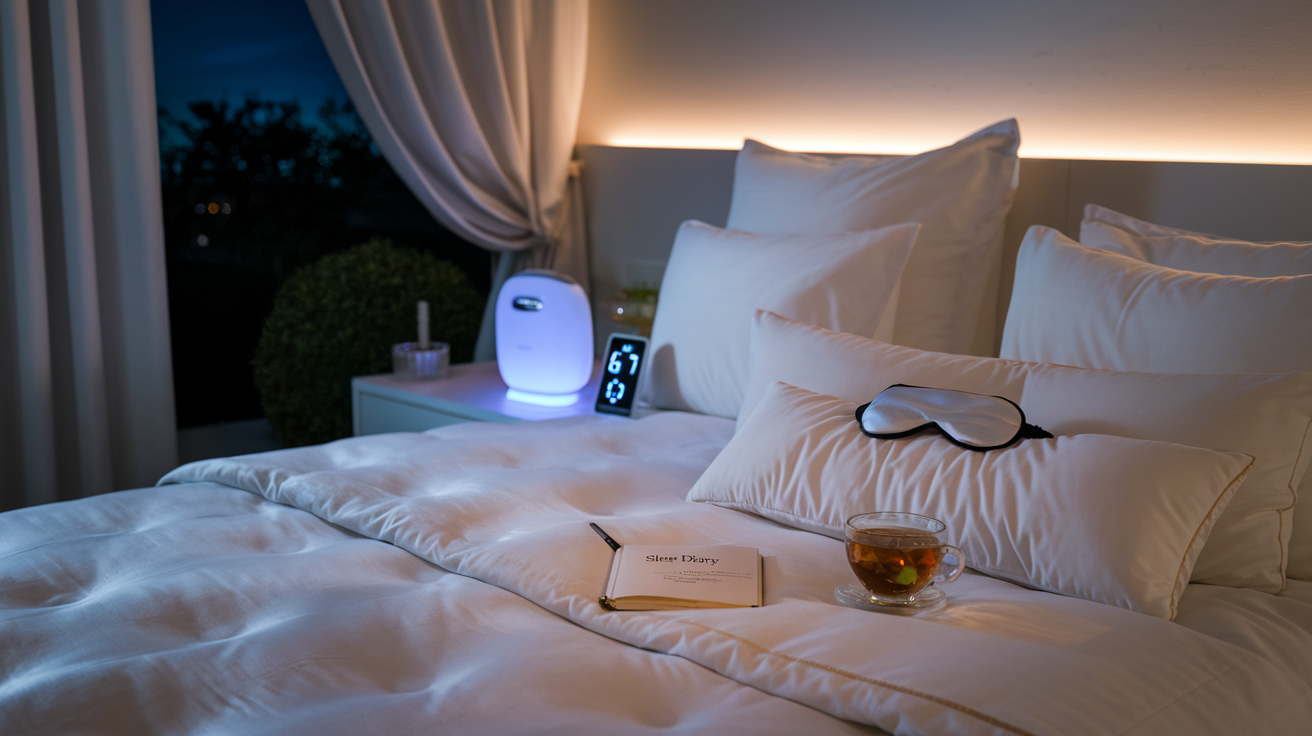Sleep Optimization: Unlock Your Full Potential Through Better Rest
Did you know that one-third of American adults don’t get enough sleep? In today’s fast-paced world, quality rest has become a luxury rather than a necessity. You toss and turn at night, wake up feeling groggy, and drag yourself through the day with the help of caffeine—only to repeat the cycle again. Poor sleep doesn’t just leave you tired; it’s linked to serious health conditions including Alzheimer’s disease, type 2 diabetes, and compromised immune function. 💤
The good news? Transforming your sleep quality is entirely within your control. From creating the perfect bedroom environment with blackout curtains and the ideal 65-68°F temperature, to establishing consistent sleep routines that work with your body’s natural rhythm—small changes can yield dramatic results. In this comprehensive guide, we’ll explore the five pillars of sleep optimization: creating the perfect sleep sanctuary, building healthy sleep habits, mastering pre-sleep relaxation, adjusting lifestyle factors that affect sleep quality, and identifying potential sleep disorders that might be sabotaging your rest. Get ready to reclaim your nights and revolutionize your days!
Creating the Optimal Sleep Environment

Creating the Optimal Sleep Environment
Your bedroom environment plays a crucial role in determining sleep quality. By optimizing these key elements, you can create the perfect sanctuary for restorative sleep.
Invest in a Quality Mattress and Bedding for Proper Support
The foundation of good sleep starts with your mattress and bedding. A suitable mattress should provide the right balance of support and comfort according to your individual preferences. Your choice of mattress type, pillow firmness, and sheet materials should align with your personal needs to ensure optimal comfort throughout the night.
Clean, well-maintained bedding not only contributes to an inviting atmosphere but also promotes healthy sleep. Experts recommend washing sheets regularly to minimize allergens that could potentially disrupt your sleep cycle.
Use Blackout Curtains or Sleep Masks to Block Light
Light exposure significantly impacts your circadian rhythms, with natural light promoting alertness during the day and darkness inducing sleepiness at night. Controlling light in your bedroom is essential for quality sleep. Blackout curtains provide an effective solution for darkening your room, especially if you live in an area with significant ambient light.
Additionally, minimizing exposure to artificial light from electronic devices before bedtime is crucial, as the blue light emitted can interfere with your body’s production of sleep hormones. If blackout curtains aren’t an option, consider using a sleep mask as an alternative.
Minimize Noise with White Noise Machines or Earplugs
A quiet bedroom environment is essential for achieving deep sleep. Loud disturbances can lead to sleep fragmentation, preventing you from reaching the most restorative sleep stages. If you can’t control external noise factors, consider using white noise machines, ambient music, or earplugs to mask unwanted sounds.
These tools can create a consistent sound environment that helps your brain filter out disruptive noises and maintain sleep continuity throughout the night.
Maintain Bedroom Temperature Between 65-68°F
Temperature plays a vital role in sleep quality. Research shows that all healthy adults experience a natural drop in body temperature while sleeping. The ideal bedroom temperature is around 65°F (18.3°C), though individual preferences may vary slightly.
Maintaining this optimal temperature range helps facilitate your body’s natural cooling process during sleep. You may need to adjust your bedding seasonally based on personal comfort to maintain this ideal sleeping temperature.
For those sensitive to air quality, ensuring proper ventilation and reducing allergens in the bedroom can prevent additional sleep disturbances. Some people also find that calming scents like lavender can enhance relaxation and improve sleep quality.
Now that we’ve covered how to create the perfect sleep environment, we’ll explore how to establish healthy sleep routines that complement your optimized bedroom space. These routines work hand-in-hand with your environment to signal your body when it’s time to wind down and prepare for restful sleep.
Establishing Healthy Sleep Routines

Establishing Healthy Sleep Routines
Now that we have optimized your sleep environment, let’s focus on establishing consistent routines that signal your body when it’s time to rest. Even the most perfect bedroom setup won’t compensate for irregular sleep habits. Creating healthy sleep routines can dramatically improve your sleep quality and overall wellbeing.
Set a Consistent Wake-Up Time Every Day
One of the most powerful sleep optimization strategies is maintaining a consistent wake-up time—even on weekends. While this might seem challenging due to various social and professional commitments, consistency is key. Experts recommend determining the earliest time you need to wake up during the week and using this as your fixed wake-up time for all seven days.
This consistency helps regulate your body’s internal clock, making it easier to fall asleep and wake up naturally. Despite the temptation to sleep in on weekends, adhering to your regular wake-up time will significantly enhance your sleep quality and overall health in the long run.
Schedule at Least Seven Hours of Sleep Nightly
Most adults require 7-9 hours of quality sleep each night. To determine your ideal bedtime, simply subtract eight hours from your fixed wake-up time, allowing extra time for falling asleep. For example, if you need to wake up at 6:00 AM, aim to be in bed by 10:00 PM.
Failing to meet your sleep requirements results in sleep debt, which can negatively impact your mental and physical health. Sufficient sleep improves daily performance, stress management, and cardiovascular health. When establishing your sleep schedule, prioritize sleep by understanding its benefits amid busy life commitments.
Limit Naps to 20 Minutes
While catching up on lost sleep through short naps can be beneficial, it’s important to keep them brief. Limit daytime naps to 20 minutes to avoid interfering with your nighttime sleep schedule. These power naps can help mitigate sleep debt without disrupting your established sleep routine.
If you consistently need naps to function, this might indicate that your nightly sleep duration or quality is insufficient, and you should reassess your sleep schedule.
Reserve Your Bed for Sleep and Intimacy Only
To strengthen the association between your bed and sleep, use your bed exclusively for sleep and intimacy. Avoid working, watching TV, or scrolling through your phone while in bed. This helps condition your brain to recognize that bedtime is for sleeping, not for stimulating activities.
Incorporating a relaxing pre-bedtime routine—such as reading a book or meditating—prepares your mind and body for restful sleep. Consider setting a soothing alarm to signal your wind-down period before bed, reminding you to begin transitioning to sleep.
With these healthy sleep routines established, we’ll next explore specific pre-sleep relaxation techniques that can further enhance your ability to fall asleep quickly and enjoy restorative rest throughout the night.
Pre-Sleep Relaxation Techniques

Pre-Sleep Relaxation Techniques
Now that we’ve established the importance of healthy sleep routines, let’s explore specific relaxation techniques that can prepare your mind and body for restful sleep. These practices serve as a bridge between your busy day and peaceful slumber, signaling to your body that it’s time to wind down.
Practice Reading or Gentle Stretching Before Bed
Engaging in calming activities before bedtime can significantly improve your ability to fall asleep. Reading a simple, non-exciting book in soft light helps transition your mind away from daily stressors. Unlike stimulating content that may keep you alert, a light read can naturally induce drowsiness.
Gentle stretching or light yoga poses can release physical tension accumulated throughout the day. These movements help:
- Relax tight muscles
- Improve circulation
- Prepare your body for a comfortable sleeping position
- Reduce physical discomfort that might disrupt sleep
Disconnect from Electronic Devices One Hour Before Sleep
The blue light emitted by screens interferes with your brain’s production of melatonin, the hormone responsible for regulating sleep. Establishing a “device curfew” at least one hour before bedtime allows your brain to naturally prepare for sleep.
Instead of scrolling through your phone, consider these alternatives:
- Listen to soothing music or nature sounds
- Have a light snack or herbal tea
- Take a warm bath to mimic your body’s natural cooling process that promotes sleep
- Engage in conversation or quiet time with family members
Implement Mindfulness or Meditation Practices
Mindfulness and meditation techniques are powerful tools for calming racing thoughts that often prevent sleep. Try these evidence-based approaches:
- Deep breathing exercises to activate your parasympathetic nervous system
- Progressive muscle relaxation to release physical tension
- Guided imagery to redirect your mind to peaceful scenarios
- Mindfulness meditation to observe thoughts without judgment
Even 5-10 minutes of these practices can significantly reduce anxiety and prepare your mind for sleep. Consistency is key—the more regularly you practice, the more effective these techniques become.
Keep a Sleep Diary to Track Patterns and Factors
Maintaining a sleep journal helps identify both helpful and disruptive factors affecting your rest. Each morning, record:
- What time you went to bed and woke up
- How long it took to fall asleep
- Any nighttime awakenings
- Pre-sleep activities and their effects
- Your overall sleep quality
After a few weeks, patterns will emerge, allowing you to refine your relaxation routine based on what works best for your unique sleep needs.
With these relaxation techniques established, we’ll next explore how various lifestyle factors affect sleep quality—from your diet and exercise habits to stress management approaches that can further optimize your sleep experience.
Lifestyle Factors Affecting Sleep Quality

Lifestyle Factors Affecting Sleep Quality
Now that we’ve explored relaxation techniques to calm your mind before bed, let’s examine how your daily habits significantly impact sleep quality. Beyond your bedtime routine, the choices you make throughout the day play a crucial role in determining how well you’ll sleep at night.
Get Daily Exposure to Natural Light
Exposure to natural light, particularly in the morning, helps regulate your circadian rhythm—your body’s internal clock. Morning sunlight signals your body to be alert and active, which later helps trigger natural sleepiness in the evening. Try to spend at least 20-30 minutes outdoors early in the day to reinforce this natural cycle. This practice works with your body’s biological processes to promote better sleep-wake patterns.
Exercise Regularly but Not Close to Bedtime
Physical activity is a powerful sleep enhancer, particularly when done in the morning. Morning exercise can invigorate your day and positively influence your circadian rhythm. However, any form of regular physical activity contributes to improved sleep quality. The key is timing—try to complete vigorous workouts at least 3-4 hours before bedtime, as exercise temporarily raises body temperature and stimulates the nervous system, which could interfere with falling asleep.
Avoid Caffeine After 2 PM
As we age, our bodies process caffeine differently. What might not have affected your sleep in your twenties could now keep you awake at night. Caffeine has a half-life of approximately 5-6 hours, meaning half the caffeine remains in your system that long after consumption. To prevent sleep disruption, avoid caffeinated beverages—including coffee, tea, and some sodas—after 2 PM. This gives your body sufficient time to metabolize the stimulant before bedtime.
Limit Alcohol and Nicotine Consumption
While alcohol might initially make you drowsy, it significantly disrupts sleep quality by preventing deeper sleep stages and causing fragmented rest. Similarly, nicotine is a stimulant that can lead to difficulty falling asleep and staying asleep throughout the night. Research indicates that excessive intake of alcoholic beverages can disrupt your natural sleep patterns and reduce overall sleep quality. For optimal sleep, minimize consumption of these substances, particularly in the hours before bedtime.
Your diet also plays a vital role in sleep quality. A diet high in saturated fats and sugars can diminish deep sleep, while fiber-rich foods from vegetables, fruits, legumes, and whole grains promote better rest. Additionally, try to balance your calorie intake throughout the day rather than consuming heavy meals close to bedtime.
With these lifestyle adjustments in place, you’ll likely see improvements in your sleep quality. However, if you continue to struggle despite implementing these changes, it might indicate an underlying sleep disorder. In the next section, we’ll explore how to identify common sleep disorders and the steps you can take to address them properly.
Identifying and Addressing Sleep Disorders

Identifying and Addressing Sleep Disorders
Now that we’ve explored how lifestyle choices impact your sleep quality, it’s important to recognize when you might be dealing with an actual sleep disorder rather than just poor sleep habits. Over 50 million Americans suffer from sleep disorders, with more than 80 recognized types that can significantly affect your overall health and daily functioning.
Recognize Key Symptoms Such as Snoring or Daytime Fatigue
Several symptoms may indicate you’re experiencing a sleep disorder:
- Persistent difficulty falling or staying asleep despite having adequate time for rest
- Excessive daytime sleepiness even after what should be sufficient sleep
- Heavy snoring, which can be a primary indicator of sleep apnea
- Difficulty performing daily activities due to fatigue
- Behavioral changes or mood disturbances related to poor sleep quality
These symptoms might point to common disorders like chronic insomnia, obstructive sleep apnea (affecting at least 30 million Americans), restless legs syndrome (impacting up to 15% of the population), or narcolepsy (affecting approximately 1 in 2,000 people).
Understand the Connection Between Sleep and Chronic Conditions
Sleep disorders can both result from and contribute to various chronic health conditions:
- Poor sleep quality increases the risk of serious health issues beyond just fatigue
- Sleep apnea is associated with breathing disruptions that can lead to long-term cardiovascular problems
- Certain medical and mental health conditions may predispose you to sleep disorders
- Women and older adults are particularly susceptible to developing sleep disorders
- Shift work disorder affects about one-third of shift workers due to disruption of natural circadian rhythms
Consider Sleep Supplements Like Melatonin
While the reference content doesn’t specifically detail melatonin use, it does mention various treatment approaches for sleep disorders:
- Sleep aids may be recommended for managing insomnia symptoms
- Treatment options vary widely depending on the specific sleep disorder diagnosed
- Lifestyle modifications often form the foundation of treatment plans
- Improving sleep hygiene practices can help supplement other treatments
- Cognitive behavioral therapy has shown effectiveness for certain sleep disorders
Know When to Consult a Healthcare Professional
Seeking medical advice is essential if you suspect you have a sleep disorder:
-
Persistent symptoms that interfere with daily functioning warrant professional evaluation
-
Diagnosis typically involves:
- Thorough examination by healthcare providers
- Sleep diaries to track patterns
- Polysomnography (sleep studies) to assess sleep quality and identify disorders
-
Treatment options will be tailored to your specific condition and may include:
- Specialized devices like CPAP machines for sleep apnea
- Medication for conditions like narcolepsy or restless legs syndrome
- Behavioral interventions to improve sleep quality
- Regular follow-ups to adjust treatment as needed
Remember that while not all sleep disorders can be prevented, early intervention can significantly improve both your sleep quality and overall health.

Embracing Better Sleep for Better Health
Optimizing your sleep environment, establishing consistent routines, practicing relaxation techniques, and addressing lifestyle factors all contribute significantly to improving sleep quality. By investing in quality bedding, maintaining an ideal bedroom temperature of 65-68°F, and minimizing light and noise disruptions, you create the foundation for restorative sleep. Paired with healthy habits like limiting caffeine after 2 p.m., avoiding alcohol before bed, and disconnecting from electronic devices an hour before sleep, these strategies form a comprehensive approach to sleep optimization.
If you continue to experience sleep difficulties despite implementing these recommendations, tracking your sleep patterns through a diary can provide valuable insights. For persistent issues like loud snoring, daytime fatigue, or shortness of breath, consulting with a healthcare professional is essential, as these may indicate underlying sleep disorders requiring specialized attention. Remember that quality sleep is not a luxury but a necessity for overall health and well-being. By prioritizing sleep and incorporating these evidence-based practices into your daily life, you’re making an investment in your physical, mental, and emotional health that will pay dividends for years to come.

